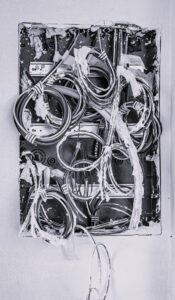When it comes to electrical safety in the workplace, one of the most important concepts is that of assured grounding. This simply means that there is a path for electricity to follow to the ground in the event of a fault. This is typically accomplished by grounding all of the electrical equipment in the area.
One of the most important aspects of assured grounding is that it provides a path of least resistance for electricity to follow in the event of a fault. This is important because it reduces the risk of electrical shock or fire. Additionally, it can help to prevent damage to electrical equipment.
There are a few different ways to provide assured grounding. The most common method is to ground all of the electrical equipment in the area. This can be done by connecting the equipment to a grounding rod or by using ground wires. Another method is to use grounding transformers. These devices are designed to create a path to ground in the event of a fault.
Assured grounding is an important concept for electrical safety in the workplace. It can help to prevent electrical shock, fire, and damage to equipment. There are a few different methods for providing assured grounding, but the most common is to ground all of the electrical equipment in the area.
Electrical Protection of Employees on Construction Sites
OSHA requires that employers shall use either ground-fault circuit interrupters or an assured equipment grounding conductor program to protect employees on construction sites.
Ground-Fault Circuit Interrupters
All 120-volt, single-phase 15- and 20-ampere receptacle outlets on construction sites, which are not part of the permanent wiring of the building or structure and which are in use by employees, shall have approved ground-fault circuit interrupters for personnel protection.
Receptacles on a two-wire, single-phase portable or vehicle-mounted generator rated not more that 5kV, where the circuit conductors of the generator are insulated from the generator frame and all other grounded surfaces, need not be protected with ground-fault circuit interrupters.
Assured Equipment Grounding Conductor Program
The employer shall establish and implement an assured equipment grounding conductor program on construction sites covering all cord sets, receptacles which are not a part of the building or structure, and equipment connected by cord and plug which are available for use or used by employees. An assured equipment grounding conductor program shall comply with the following minimum requirements:
A written description of the program, including the specific procedures adopted by the employer. The description and procedures shall be available at the jobsite for inspection and copying by OSHA and any affected employee.
The employer shall designate one or more competent persons to implement the program.
Each cord set , attachment cap, plug and receptacle of cord sets, and any equipment connected by cord and plug, except cord sets and receptacles which are fixed and not exposed to damage, shall be visually inspected before each day’s use for external defects, such as deformed or missing pins or insulation damage, and for indications of possible internal damage. Equipment found damaged or defective shall not be used until repaired.
The following tests shall be performed on all cord set, receptacles which are not a part of the permanent wiring of the building or structure, and cord-and plug-connected equipment required to be grounded.
All equipment grounding conductors shall be tested for continuity and shall be electrically continuous.
Each receptacle and attachment cap or plug shall be tested for correct attachment of the equipment grounding conductor. The equipment grounding conductor shall be connected to its proper terminal.
All required tests shall be performed:
- Before first use.
- Before equipment is returned to service following any repairs.
- Before equipment is used after any incident which can be reasonably suspected to have caused damage (for example, when a cord set is run over).
- At intervals not to exceed 3 months, except that cord sets and receptacles which are fixed and not exposed to damage shall be tested at intervals not exceeding 6 months.
The employer shall not make available or permit the use by employees of any equipment which has not met these four requirements.
Tests performed as required in the preceding paragraph shall be recorded. This test record shall identify each receptacle, cord set, and cord- and plug-connected equipment that passed the test and shall indicate the last date it was tested or the interval for which it was tested. This record shall be kept by means of logs, color coding, or other effective means and shall be maintained until replaced by a more current record. The record shall be made available on the jobsite for inspection by OSHA and any affected employee.
One of the methods listed by OSHA as part of acceptable record keeping is to establish a color code for marking cord sets and cord- and plug-connected equipment. The table below lists a color code that is in wide use by electricians and contractors. Colored plastic or vinyl electrical tape is placed on one or both ends of cords and cord- and plug-connected equipment to denote the month that the tests were performed.
| Assured Equipment Grounding ConductorProgram Color Code | |||
| Month # | Month Tested | Color of tape(s)to apply to cord | |
| 1 | January | White | |
| 2 | February | White + | Yellow |
| 3 | March | White + | Blue |
| 4 | April | Green | |
| 5 | May | Green + | Yellow |
| 6 | June | Green + | Blue |
| 7 | July | Red | |
| 8 | August | Red + | Yellow |
| 9 | September | Red + | Blue |
| 10 | October | Orange | |
| 11 | November | Orange + | Yellow |
| 12 | December | Orange + | Blue |
White in January for Winter Green in April for Spring Red in July for Summer, or the 4th of July Orange in October for Fall, or pumpkins.
Then add: Yellow for the second month in each quarter, Blue for the third month of each quarter.
OSHA Definition
“Competent person” means one who is capable of identifying existing and predictable hazards in the surroundings or working conditions which are unsanitary, hazardous, or dangerous to employees, and who has authorization to take prompt corrective measures to eliminate them.
Disclaimer: The information presented on this page is taken from the Occupational Safety and Health Administration Regulations (Standards – 29 CFR) 1926.404 – Wiring Design and Protection. The presentation and use of this material is not intended to be an interpretation of those regulations. Please refer to the Regulations for the full text and interpretation of the Regulations and Standards.
What are the tests required for assured grounding?
Most of us are unaware of the importance of electrical grounding. We take it for granted that our electrical systems are safe. However, there are many potential hazards associated with electrical systems that are not properly grounded. Assured grounding is a method of ensuring that an electrical system is safe by testing the system to verify that it is properly grounded.
There are three main tests that are used to verify that an electrical system is properly grounded: the ground resistance test, the ground continuity test, and the ground potential test.
The ground resistance test is used to measure the resistivity of the soil in which the grounding system is installed. The results of this test are used to determine the size and type of grounding system that is required.
The ground continuity test is used to verify that the grounding system is able to conduct electricity. This test is performed by connecting a voltmeter to the grounding system and measuring the voltage drop across the system.
The ground potential test is used to verify that the grounding system is able to dissipate electrical energy. This test is performed by connecting a current meter to the grounding system and measuring the current flow through the system.
Assured grounding is a critical part of ensuring the safety of electrical systems. By testing the system to verify that it is properly grounded, we can be sure that the system will not pose a hazard to people or property.
What is OSHA grounding?
When it comes to electrical safety in the workplace, OSHA grounding is one of the most important things to know about. OSHA grounding is a method of protecting workers from electrical shock by creating a safe path for electrical current to travel in the event of a fault. Grounding is achieved by connecting electrical equipment and wiring to a grounding rod or other grounding system.
Grounding systems are designed to provide a low-resistance path to ground for electrical current in the event of a fault. This low-resistance path allows the current to flow to ground without causing harm to workers. Grounding systems also help to protect equipment from damage by providing a safe path for the current to travel.
There are two types of grounding systems: static and dynamic. Static grounding systems are typically used in facilities where there is a low risk of electrical shock. Static grounding systems are typically used in facilities where there is a high risk of electrical shock. Dynamic grounding systems are typically used in facilities where there is a high risk of electrical shock.
OSHA requires that all electrical equipment and wiring be grounded. Grounding is required for all circuits, including those that are not energized. Grounding is also required for all electrical equipment that is exposed to moisture or other conductive materials. Grounding rods must be driven into the ground to a depth of at least 8 feet. Grounding systems must be tested periodically to ensure that they are functioning properly.
How often do assured equipment grounding programs require visual inspections?
Which systems require grounding OSHA?
There are many different types of electrical systems, and each one has different requirements for grounding. OSHA (the Occupational Safety and Health Administration) has established specific requirements for grounding electrical systems in the workplace.
The first step in determining which grounding system is required is to identify the type of electrical system. The three major types of electrical systems are grounded, ungrounded, and isolated.
A grounded system is one that has a conductor that is intentionally connected to earth. This conductor provides a low-resistance path to ground, which helps to protect against electrical shock. Grounded systems are typically used in residential and commercial buildings.
An ungrounded system is one in which there is no intentional connection to earth. This type of system is more likely to cause electrical shock, because there is no path to ground for the current to follow. Ungrounded systems are typically found in industrial settings.
Isolated systems are those in which the conductors are not intentionally connected to earth. These systems are used in situations where electrical shock is not a concern, such as in aircraft.
Once the type of electrical system has been identified, the next step is to determine the specific grounding requirements. OSHA has established different requirements for each type of system.
For grounded systems, OSHA requires that a grounding conductor be used. This conductor must be connected to earth, and it must be of a size and material that is suitable for the purpose.
For ungrounded systems, OSHA requires the use of an equipment grounding conductor. This conductor must be connected to each non-current-carrying metal part of the equipment. The conductor must be sized and installed in accordance with the manufacturer’s instructions.
For isolated systems, OSHA requires the use of an insulation barrier. This barrier must be placed between the live parts of the system and the earth. The barrier must be of a material that is suitable for the purpose.
OSHA’s requirements for grounding electrical systems are designed to protect workers from electrical shock. By following these requirements, employers can help to ensure a safe working environment.
What are the 2 types of grounding?
There are two types of grounding: electrical grounding and earthing.
Electrical grounding is the process of creating a conductive path between a circuit and the earth. This conductive path provides a low impedance path for currents to flow, preventing voltage Build-up and protecting equipment from electrical damage.
Earthing, on the other hand, is the process of creating a conductive path between a circuit and the ground. This conductive path provides a safe path for electrical current to flow, preventing voltage build-up and protecting equipment from electrical damage.
What is the difference between earthing and grounding?
There is often confusion between earthing and grounding. Though they are similar, there is a vital difference between the two. Both earthing and grounding provide a low impedance path to the earth to protect against voltage surges, but they differ in their function and purpose.
Earthing is the low impedance path to the earth that is used to dissipate static electricity or to protect against voltage surges. The earthing system connects the non-current carrying metal parts of an electrical system to the earth. This dissipates any static electricity that has accumulated on these metal parts and protects against any voltage surges.
Grounding, on the other hand, is the low impedance path to the earth that is used to protect against electrical faults. The grounding system connects the current carrying parts of an electrical system to the earth. This limits the amount of current that can flow in the event of an electrical fault.
Both earthing and grounding are important parts of an electrical system. Earthing protects against voltage surges while grounding protects against electrical faults.
How long should you ground each day?
This is a difficult question to answer due to the fact that there is no set amount of time that is required for grounding. Some people may only need to ground for a few minutes each day, while others may need to do it for hours. It really depends on the individual and their own personal needs.
That being said, there are a few general guidelines that can be followed when it comes to grounding. First of all, it is important to ground yourself regularly, even if you don’t feel like you need to. This is because grounding can help to prevent negative energy from building up in your system. It is also a good idea to ground yourself after you have been exposed to a lot of negative energy, such as after a fight with a friend or a stressful day at work.
In terms of how long you should ground for, it is generally recommended to do it for at least 10-15 minutes each day. This will give you enough time to clear out any negative energy that you may have picked up during the day. If you have the time, you can also ground for longer periods of time, such as 30 minutes or even an hour.
Ultimately, the best way to figure out how long you should ground for is to experiment and see what works best for you. Start with a few minutes each day and gradually increase the amount of time you spend grounding yourself until you find a balance that feels right for you.
Can you wear socks when grounding?
There are a few schools of thought on this matter. Some people believe that socks insulate you from the earth’s energy, while others believe that socks actually help ground you.
If you’re interested in trying grounding but are unsure about whether or not to wear socks, we suggest doing a little experiment. Try grounding with socks on for a few days and see how you feel. If you don’t notice any difference, try grounding without socks and see if you notice a difference then. There’s no right or wrong answer here, it’s all about what works for you.
If you’re interested in grounding but don’t have access to bare ground (for example, if you live in an apartment), you can also try using a grounding mat. Grounding mats are made of conductive material that allows you to ground yourself indoors.
What happens if grounding is not done properly?
If you are in the process of electrical work, it is important to do the grounding correctly. If not, you may be putting yourself and your family in danger. Here is what can happen if grounding is not done properly:
If you are working with electricity, you must ground yourself to avoid being electrocuted. Grounding provides a safe path for electrical current to follow in the event of a short circuit, fault, or other problem. Without grounding, electrical current would have nowhere to go but through you, which could result in serious injury or even death.
There are three main types of grounding: direct, indirect, and static. Direct grounding is the most common and involves attaching a grounding wire directly to the metal frame of the electrical panel. Indirect grounding occurs when the grounding wire is attached to a pipes or other metal objects that are in contact with the earth. Static grounding is when the electrical current is discharged into the earth through a grounding rod.
If you are not properly grounded, you may be at risk for electrical shock, fire, or explosions. In the event of a short circuit, the current would have nowhere to go but through you, which could cause serious injury or even death. Even if the electrical current does not go through you, it can still damage your appliances and electronics.
To avoid these dangers, it is important to make sure that you are properly grounded. If you are not sure how to ground yourself, consult a professional electrician.
How often should grounds be tested?
It’s important to have a regular testing schedule for your grounds, but how often you test will depend on a few factors. If you have a small, localized problem, you can test more frequently. If you’re dealing with a larger problem or you’re trying to prevent contamination, you’ll need to test less often.
Here are a few general guidelines:
-If you have a new food product or you’re changing your manufacturing process, test more frequently at first.
-If you’re not sure how often to test, start with once a week and adjust as needed.
-If you have a problem with contamination, test daily until you find the source of the problem.
But remember, these are just guidelines. The best way to figure out how often to test your grounds is to talk to a professional. They can help you develop a testing schedule that’s tailored to your specific needs.
What systems require grounding?
Grounding is an important safety measure in electrical systems. It helps to protect people and equipment from electrical shock and fire. All electrical systems need to be grounded, including:
-Home electrical systems
-Commercial and industrial electrical systems
-Telephone and data systems
-Lightning protection systems
Grounding provides a path for electrical current to flow in the event of a short circuit or other fault. This current can then be safely diverted away from people and equipment. Grounding also helps to protect against electrical surges, such as those caused by lightning strikes.
without a proper grounding system, even a small electrical fault can cause a dangerous electrical shock or fire. That’s why it’s so important to make sure that all electrical systems are properly grounded.
What is the OSHA standard for electrical safety?
The Occupational Safety and Health Administration (OSHA) is a federal agency that sets and enforces safety standards in the workplace. OSHA’s standards for electrical safety are set forth in the Code of Federal Regulations (CFR) Title 29, Part 1926. These standards are designed to protect workers from electrical hazards while working on or near electrical equipment.
Some of the key provisions of the OSHA standards for electrical safety include:
- Provisions for the use of personal protective equipment (PPE) such as gloves, face shields, and insulating mats.
- Requirements for the proper use of electrical tools and equipment.
- Guidelines for working in confined spaces.
- Procedures for de-energizing and grounding electrical equipment.
- Limits on the use of extension cords.
- Requirements for labeling electrical equipment and cords.
- Procedures for investigating electrical incidents.
By following the OSHA standards for electrical safety, workers can protect themselves from serious injuries or even death.
Conclusion
We hope this blog post “Assured Grounding” has helped clear up any confusion you may have had. If you have any further questions, feel free to reach out to us and we would be happy to help!
Hey, check out: Offset Bends
Today sponsors are Localhandymantulsa.com , Sprinkler Repair Long Island , Mailboxrepairtulsa.com , Chestercountytowingservices.com and Huttotxroofrepair.com. Always providing the best services in town.









